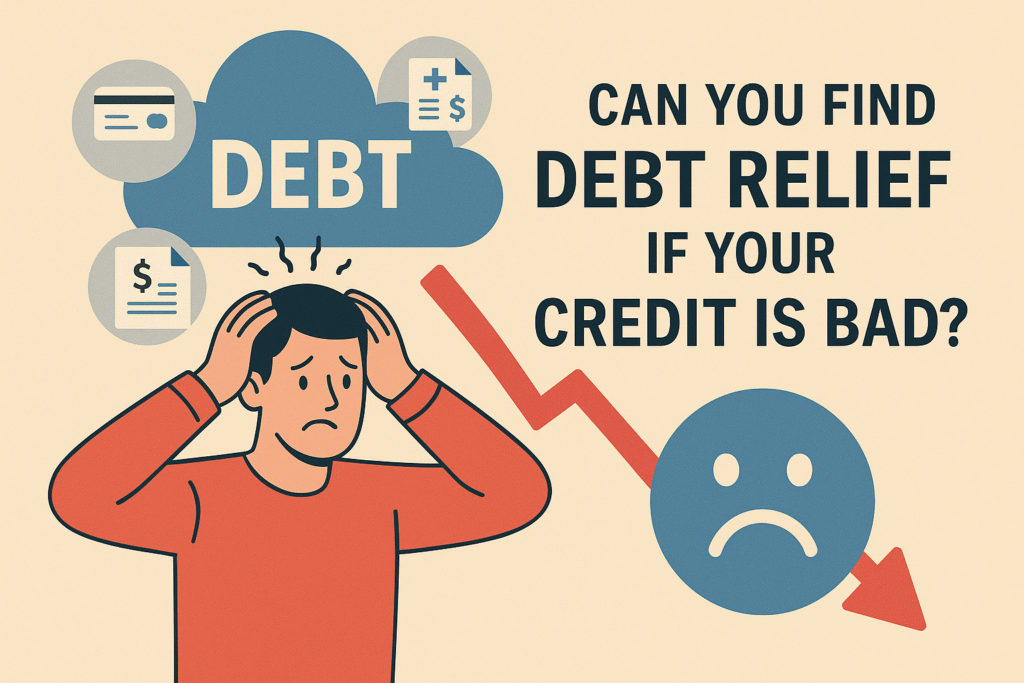
Can You Find Debt Relief If Your Credit Is Bad?
Being in debt is already stressful, but if you add bad credit on top of it, it can feel totally overwhelming. High-interest credit cards, medical bills, and loan payments can get out of hand fast, and before you know it, it’s impossible to catch up. There is some good news, though — a low credit score doesn’t completely take away your options.
With bad credit, usually a score of 600 or less, there are still quite a few ways to lower your payments, simplify your financial situation, and start making real progress. The important thing is to understand which of the available strategies will actually work for your specific situation.
How Debt Consolidation Actually Works
Debt consolidation is one of the most common debt relief strategies. The idea behind it is to take multiple high-interest balances and pay them off with a single loan — hopefully at a lower rate with a lower total payment amount. That means fewer due dates to manage each month and, hopefully, less total interest paid.
Here are some ways people consolidate debt:
How much unsecured debt do you have?
Choose an option to check relief eligibility:
Takes less than 60 seconds. No obligation.
1. Personal Loans
This involves taking a single lump-sum loan to pay off your existing balances. Then, you just repay that one loan, which has a fixed monthly payment. Think of it like a car loan where you pay the same amount each month, and when it’s paid off, it’s paid in full. The same concept applies here — you’re just using the loan to pay off higher-interest debt rather than using it to buy a vehicle.
2. Credit Card Balance Transfers
Many credit card companies offer balance transfers as low as 0%. Sometimes they will offer those on your current cards, or you may have to apply for a new card. Either way, this can be a great money-saver for the amount of time they offer (typically 12 to 18 months). You’ll want to be sure you understand the fees associated with the transfer and what the interest rate will be after that promo rate expires. You don’t want to end up in a worse position than you started if you’re not able to pay off the full transfer before the rate goes up.
3. Debt Management Plans (DMPs)
These are usually offered by nonprofit credit counseling businesses. In essence, they negotiate with your creditors to get them to lower your interest rates and/or waive fees that have been applied to your account. Then, they combine everything into one payment that you make to the agency, and they pay your creditors. It’s not a new loan — it’s a structured repayment plan to help you get back on track.
This does come with some risk, though, so do your homework to make sure they aren’t going to tell you to stop making payments on your current cards while they negotiate. That can hurt your score even more.

Options for People Who Have Bad Credit
If your credit score dips below 600, it definitely gets harder to get approved, but it’s not impossible. Some lenders, especially local credit unions, will take the time to look beyond the number on a piece of paper. They can weigh your income, payment history, and how stable your employment situation has been.
Don’t misunderstand — you will still probably be charged higher interest than someone with good credit, but odds are it’ll still be less than what you’re paying on your current balances. And having just one payment to manage makes things a lot less stressful than managing multiple due dates throughout the month.
Another option people often choose are secured loans, which are loans backed by something tangible like a house or vehicle. These types of loans are often easier to qualify for but they do have risk since you have to back the loan with something that can be repossessed if you default.
Unsecured loans are also sometimes an option. These types of loans don’t require any collateral, but lenders will usually tighten up terms and increase rates if your credit score is low.
Both of those options can be good solutions to help manage high-interest debt.
What Else Can You Do to Tackle Debt?
If nothing we’ve discussed so far is a fit, there are still some other options to think about. Some do involve some risk, but depending on your situation, they may still be worth it for the long-term relief they can provide.
1. Debt Settlement
In this option, you would employ a settlement company to negotiate with your creditors on your behalf to reduce the amount you owe. This often involves a one-time lump-sum payment to pay off your account. At first glance, this can seem like a great option, but it’s not without risk or potential downsides.
Many of these agencies require you to stop making payments while they are negotiating with your creditors. This will likely cause your credit score to go even lower and put you at risk of being sent to collections or even getting sued, so be sure to do your research before proceeding.
2. Using Home Equity or Retirement Funds
If you happen to own a house, something like a home equity line of credit or loan can give you access to part of the value of your home in the form of cash. Again, this sounds great, but you will be putting up your house as collateral — so if you were to miss payments, that could put your home at risk.
Tapping into your retirement accounts like a 401(k) or IRA can provide some short-term relief, but come tax time, you could face a hefty tax bill along with other fees and penalties. In addition, you’re looking at less money saved for your future retirement.
3. Credit Repair Before Applying for Loans
Something to consider before applying for any new loans is seeing if you can repair your credit first. Check your credit report to see if there are any errors, then ask the bureaus to remove those items. This can usually be done by filling out a simple form on their websites.
You might also consider paying down higher balances and bringing any past-due accounts current. This can be a catch-22 situation, though. If you have the money to do these things, you probably don’t need a consolidation loan anyway. But keep in mind that even a small increase to your score can have a big impact on the terms of loans you apply for.
4. Local and Nonprofit Support
Don’t forget about support you may find locally. Many cities and communities have nonprofit organizations, churches, or other local programs designed to help with things like short-term bills, food, utilities, or rent. They usually don’t require any sort of credit check and can buy you a little time to regroup and get your affairs in order.
Bottom Line
Can you find debt relief if your credit is bad? Yes — you can find relief, but it’ll likely take more planning, patience, and research. It doesn’t matter if you are looking at consolidation loans, debt management plans, or any other strategy — the most important thing is finding the option that fits your current situation the best. That’s not to say you can’t change direction in the future, but always do your research to be sure you’re going to be in a better situation after you take action than you were before. You don’t want to start down a path that puts you in a worse position that could lead to devastating results like bankruptcy.
The best way is to start by taking a look at your credit report, income, and expenses. Then, when you know what your situation actually looks like, you can talk to a credit counselor or trusted lender to learn your actual options and start getting yourself out of debt. From there, you’ll be on the path to rebuilding your finances.


